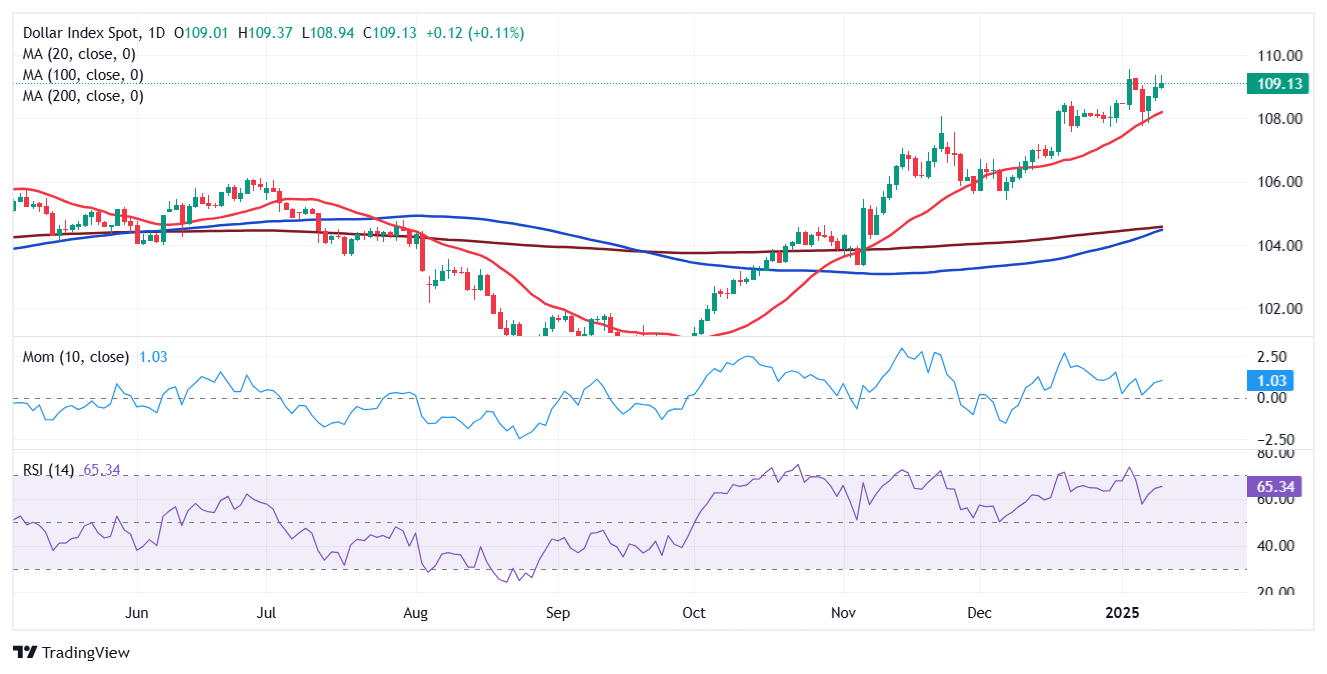NFP is the acronym for the Nonfarm Payrolls report, a compilation of data reflecting the employment situation in the United States (US). It shows the total number of paid workers, excluding those employed by farms, the federal government, private households, and nonprofit organisations.
The headline figure, expressed in thousands, is an estimate of the number of new jobs added (or lost, if negative) in a given month.
But the report also includes the country’s Unemployment Rate, the Labor Force Participation Rate (or how many people are working or actively seeking a job compared to the total population) and Average Hourly Earnings, a measure of how wages increase or decrease month over month.
Why is NFP important for Forex markets?
The Forex (FX) market pays extra attention to the US macroeconomic figures, as they reflect the health of the world’s largest economy. Employment data is particularly relevant because of the Federal Reserve (Fed) mandate. “The Fed's modern statutory mandate, as described in the 1977 amendment to the Federal Reserve Act, is to promote maximum employment and stable prices. These goals are commonly referred to as the dual mandate,” according to the central bank itself.
Generally speaking, a solid increase in job creation coupled with a low Unemployment Rate is usually seen as positive for the US economy and, hence, the US Dollar (USD). On the contrary, fewer-than-expected new jobs tends to hurt the US Dollar.

However, nothing is written in stone in the FX market.
Ever since the Coronavirus pandemic, markets’ dynamics have changed. The overextended lockdowns and the subsequent reopenings had an unexpected effect: soaring global inflation.
As prices increased fast, central banks had no choice but to lift interest rates to tame inflation. This is because high rates make it more difficult to borrow money, reducing the demand for goods and services from households and companies and thus keeping prices at bay.
Interest rates reached multi-decade peaks in 2022-2023, and economies cooled. But inflation took long to recede. In fact, most major economies are still seeing how prices grow by more than what central bankers would like to.
In the case of the US, the Fed’s goal is for prices to grow at an annual pace of around 2%. Despite having retreated from the highs posted in mid-2022, price pressures remain above desired.
Ahead of the announcement, the US released a couple of relevant reports: On the one hand, the ADP report on private job creation showed the sector added 122,000 new positions in December, missing expectations of 140,000. Meanwhile, the number of job openings on the last business day of November stood at 8.09 million, according to the Job Openings and Labor Turnover Survey (JOLTS) report. This reading followed the 7.83 million reported in October and came in above the market expectation of 7.7 million.
The optimistic figures hint at another month of solid job creation in the US.
But what does employment have to do with the Fed?
Keeping unemployment subdued is also part of the Fed’s mandate, but a strong labor market usually translates into higher inflation. The Fed is in a tough balancing act: controlling inflation can mean more job losses, while a very strong economy can mean higher inflation.
The Chairman of the Fed, Jerome Powell, has long said the central bank needs a “weaker” labor market, meaning that the economy creates fewer jobs, to trim interest rates.
The US economy has consistently performed very well after the pandemic, creating plenty of jobs month after month. Even though this seems a desirable situation for the country, the Fed read it as a potential risk to inflation. To tame price pressures, US policymakers kept interest rates high for as long as possible.
Finally, the Fed decided to trim interest rates, delivering a 50 basis points (bps) rate cut in September, followed by a 25 bps cut in November and a similar move in December.
Yet, there is one more twist to the story. The US had a presidential election in 2024, which brought Republicans, led by former President Donald Trump, back to the government. Trump will take office on January 20, but his plans have already taken their toll on financial markets and the Fed.
President-elect Donald Trump has pledged to impose massive import tariffs on friends and enemies to “protect” the local economy. As a result, the Fed has shifted the focus back to prices, anticipating higher inflationary pressures amid increased import costs. Not only did the central bank change the North, but it also adopted a more hawkish monetary policy stance, anticipating just two potential rate cuts in 2025.
As a result, employment-related data is having a decreased impact on the US Dollar, as the Fed’s attention remains elsewhere.

What to expect from the December NFP report?
The November NFP report showed that the US economy created 227,000 new jobs in the month, while the Unemployment Rate was confirmed at 4.2%. The US Dollar strengthened with the news, finishing the day with substantial gains against most major rivals, as the upbeat figure fell short of affecting the Federal Reserve’s stance.
For December, economists expect the US economy to have created 160,000 new positions, another solid figure. At the same time, the Unemployment Rate is foreseen to remain steady at 4.2%.
If that’s the case, financial markets will likely welcome the continued job creation and steady unemployment rate, allowing the Fed to maintain its recently adopted path when they meet on January 28-29.
An NFP report showing fewer jobs created than what is expected could spur concerns about the labor market’s performance.
Hence, the USD will then fall.
Finally, a report indicating solid job creation should boost the market’s mood and, hence, the US Dollar, as it would indicate a resilient economy.
As always, regarding macroeconomic data, the divergence between expectations and the actual result will determine the strength of directional movements across the FX board.
The more significant the deviation, one way or the other, the wider the market reaction. Either extremely upbeat or shocking poor readings will exacerbate the directional movements.
Information on these pages contains forward-looking statements that involve risks and uncertainties. Markets and instruments profiled on this page are for informational purposes only and should not in any way come across as a recommendation to buy or sell in these assets. You should do your own thorough research before making any investment decisions. FXStreet does not in any way guarantee that this information is free from mistakes, errors, or material misstatements. It also does not guarantee that this information is of a timely nature. Investing in Open Markets involves a great deal of risk, including the loss of all or a portion of your investment, as well as emotional distress. All risks, losses and costs associated with investing, including total loss of principal, are your responsibility. The views and opinions expressed in this article are those of the authors and do not necessarily reflect the official policy or position of FXStreet nor its advertisers. The author will not be held responsible for information that is found at the end of links posted on this page.
If not otherwise explicitly mentioned in the body of the article, at the time of writing, the author has no position in any stock mentioned in this article and no business relationship with any company mentioned. The author has not received compensation for writing this article, other than from FXStreet.
FXStreet and the author do not provide personalized recommendations. The author makes no representations as to the accuracy, completeness, or suitability of this information. FXStreet and the author will not be liable for any errors, omissions or any losses, injuries or damages arising from this information and its display or use. Errors and omissions excepted.
The author and FXStreet are not registered investment advisors and nothing in this article is intended to be investment advice.
Recommended Content
Editors’ Picks

AUD/USD side-lines near 0.6200 as traders await US NFP report
AUD/USD consolidates near 0.6200 early Friday, just above its lowest level since October 2022 as traders move to the sidelines ahead of Friday's closely-watched US NFP data releae. Meanwhile, rising bets for an early RBA rate cut, China's economic woes and US-Sino trade war fears act as a headwind for the Aussie.

USD/JPY bulls take a breather above 158.00 ahead of US NFP
USD/JPY takes a breather above 158.00 following the release of household spending data from Japan, slightly off the multi-month top amid wavering BoJ rate hike expectations. However, the widening of the US-Japan yield differential keeps the pair supported amid a bullish US Dollar. US NFP data awaited.

Gold price consolidates below multi-week top; looks to US NFP for fresh impetus
Gold price enters a bullish consolidation phase below a four-week top touched at $2,678 on Thursday as bulls await the US NFP report before placing fresh bets. In the meantime, geopolitical risks, trade war fears and a weaker risk tone might continue to act as a tailwind for the safe-haven XAU/USD.

Ripple's XRP plunges over 4% following funding rates decline
Ripple's XRP declined 4% on Friday following a decline in its funding rates. The remittance-based token could decline to test the $2.17 support level if the crypto market decline extends.

How to trade NFP, one of the most volatile events Premium
NFP is the acronym for Nonfarm Payrolls, arguably the most important economic data release in the world. The indicator, which provides a comprehensive snapshot of the health of the US labor market, is typically published on the first Friday of each month.

Best Forex Brokers with Low Spreads
VERIFIED Low spreads are crucial for reducing trading costs. Explore top Forex brokers offering competitive spreads and high leverage. Compare options for EUR/USD, GBP/USD, USD/JPY, and Gold.